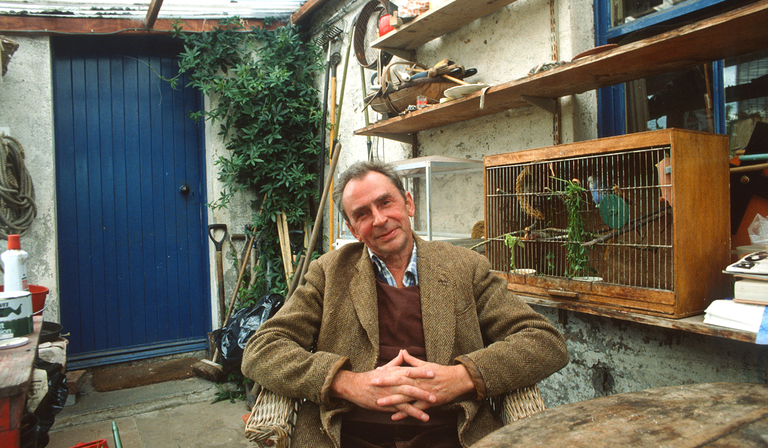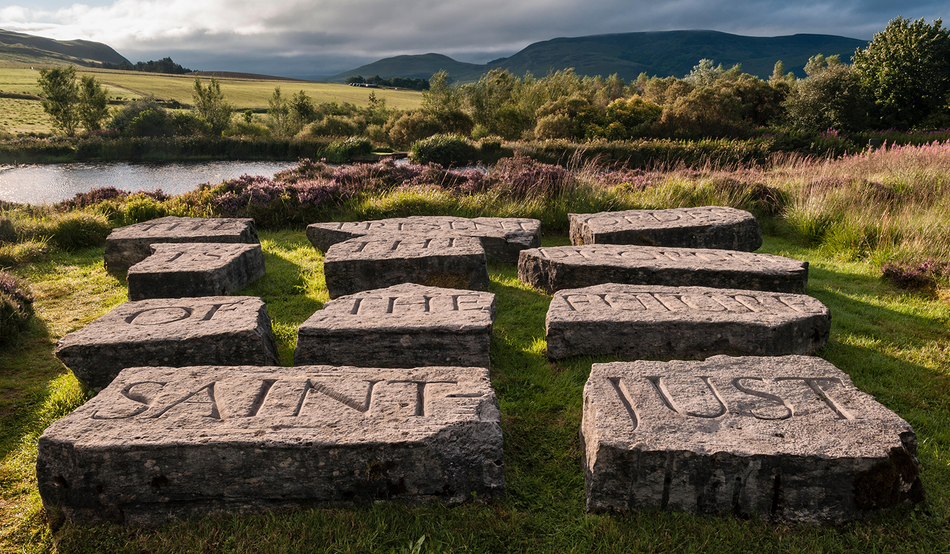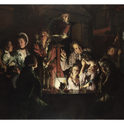It will come as no surprise to those familiar with his work that the centenary of the Scottish poet and artist Ian Hamilton Finlay (1925-2006) has brought contested appraisals. In a review of an exhibition at the Victoria Miro Gallery in May, the Guardian’s Jonathan Jones saw a “shallow, adolescent mind”; the Observer’s Laura Cumming, in a review of the Scottish Gallery of Modern Art’s own retrospective, reflected on an oeuvre “refined, philosophical, antic in its wit and elegance”.
Some of this polarisation is inevitable and even intentional, perhaps, given the nature of Finlay’s life and work. Motifs of conflict and violent destruction—battleships, guillotines, machine guns and hand grenades—are all incongruously present alongside the arcadian and serene. This is a centenary for an agoraphobic poet once notorious for maintaining a small militia of supporters who vandalised the office of the Evening Standard’s art critic Brian Sewell; an artist who employed the help of collaborator Jessie McGuffie to “defend” his project by punching the literary editor of the Scotsman in 1962.
But what gets lost amid accounts of the heroics and controversies surrounding Finlay’s work is the basic fact that the status of poetry in Scotland was contested throughout the span of his life. In 2004, Scotland’s young democratic institutions decided that a “National Poet for Scotland” was required; arguably an attempt to resolve debates about the proper place of letters in the national psyche. The role was notably designated the old Scots term makar. Here was an antidote to the long—and frequently dull—line of poets laureate, the implication being that Scotland could claim a literary tradition that was older yet more alive than the succession of sherry swilling royal rhymers in London.
In contrast to his contemporary and ally Edwin Morgan, Finlay never occupied the office of national bard. But the term’s ambiguity remains fitting for a poet and artist who defies categorisation. The Dictionary of the Scots Language lists eight definitions of makar, including: “One who fashions, constructs, produces, prepares”; “The Creator. Said of God, Christ or Nature”; and “One who promulgates a law”.
Indeed, Finlay’s contribution is remarkable for including all of the above: here was a maker—intent on shifting poetry off the page and into a wide variety of sculptures, constructed monuments and material objects—but also a creator, fashioning an Edenic base for himself in a rural Pentland farm called Stonypath, replete with altars and tablets of stone. In 1979, he turned legislator, founding at Stonypath a quasi-satirical micro-state which he christened Little Sparta, a territory positioned in staunch opposition to the cultural establishment in Edinburgh (the “Athens of the North”). However, despite this expansive journey beyond the lyrical, Finlay’s chosen epitaph for his grave—given simply as “poet”—suggests a continuity running through all these projects.
One thread is identified by Finlay’s son Alec, who links the ancient makar tradition to his father’s membership of “a generation of innovators who grasped the poetic means of production”. Concrete poetry—perhaps the ultimate expression of lyrical modernism—became the poet’s definitive and lifelong form of literary rebellion. But earlier efforts, including the founding of Wild Hawthorn Press in 1958, the periodical Poor. Old. Tired. Horse (1962-67) and Glasgow Beasts, an a burd (1961) had already unsettled received assumptions about the Scottish literary tradition.
The arrival of Finlay’s cohort on the literary scene saw a series of particularly intense, occasionally surreal flytings—a Scots form of gladiatorial intellectual dispute and insult, historically as exchanges of verse—between an older generation of poets, led by Finlay’s estranged former mentor Hugh MacDiarmid, and a younger cohort including Finlay and Morgan. This young team were intent on opening Scottish letters to a world of popular, folk and avant-garde currents then newly alive in the wake of the beat generation. Finlay took to the fray with characteristic zeal, promoting a fake protest march and promising to burn Scottish literary grandees in effigy; a happening that (although fictional) was nonetheless banned by a local magistrate.
In Finlay’s mind, there was a seamless extension between his early forays into concrete poetry and later works embodied in stone, wood or the landscape itself. Little Sparta, open to the public for just a few months of the year between June and September, still blooms amid the sparse pastoral uplands: few artists can dream of a magnum opus at once so monumental, tangible and well-preserved. But where does Finlay’s broader legacy sit today?
Scotland’s poetic struggles, emerging from the horror and lacunae of the first half of the 20th century, were at once revolutionary and conservative. The provincial sentimentality associated with aspects of Scottish life and letters had to be cleared away, while other distinct and firmly rooted traditions had to be revived and renewed.
Another makar, Kathleen Jamie, recently noted of the newly updated Canongate Wall, a section of the Scottish parliament that bears a range of notable Scottish verses: “I think poetry suits stone, more than it suits paper. The poetry releases something latent in the stone. Wry bedrock wisdom.”
It also implies a permanency, the notion that words can be set in stone. But it is hard not to conclude, with Alec Finlay, that so much of what was thought to be settled in Scottish culture has proved rather flimsy, with freelancers who live by art commissions now discussing “end times” for their practice in contemporary Scotland. The arts establishment that Finlay once railed against is impoverished. The Scottish broadsheets that once breathlessly reported literary conflicts are a shadow of the institutions they once were; the nation’s single long-running quality literary journal, The Dark Horse, lacks long-term funding. A recent edition of the Belfast-based Irish Pages covered this Scottish cultural malaise in depth. Of the many Scots cultural “elders” they had assembled, the editors noted: “None is happy. None particularly optimistic.”
Even the Scottish cultural mainstream that an avant-garde could once tug against is hard to find beyond a handful of biddable agencies and acronyms, with flagship cultural institutions—theatres, galleries, cinemas—chronically underfunded and in a post-pandemic permacrisis of existential proportions. In a different era, Finlay’s set-piece performance “Battle of Little Sparta” involved a now unthinkable confrontation with Strathclyde Regional Council over the payment of business rates. What artist today, eyeing their mortgage and ever-more fragile income streams, would dare to blur the lines between resistance to authority and art itself?
High in the Wild Garden section of Little Sparta, laid out before distant moorland, the work “Little Fields Long Horizons” offers a credo for how the microcosm of our own patch is always implicated in the wider scheme of things. Scotland’s current cultural crisis stems from a failure of long-term political perspectives, from a lack of confidence to plant and nurture diversity or discomfort for the sheer joy of finding out where it might lead us. Until a renewed sense of revival and disputation emerges to reoccupy what’s left of the Scottish cultural sphere, the Canongate Wall will seem all too like a tombstone for radical and dissenting voices, squeezed by the political establishment into a memorial role.
When they arrive in culturally barren moments, centenaries are strange creatures. They often remind us of the basic incongruity of contemporary life with all that is being commemorated. Finlay is no exception. But perhaps we can take a slice of possibility from his response when asked to stage his own piece of commemorative work: “My Proposal for the Bicentenary of the [French] Revolution: A Revolution.”














